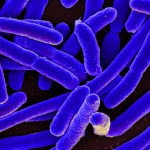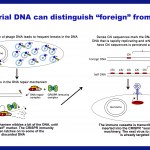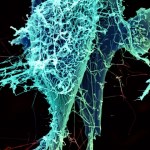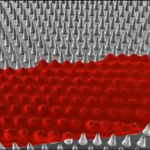bacteria
Antibiotic-resistant bacteria are a pretty scary thing, which is why researchers are working so hard to come up with new and creative ways to fight them off. Take for example nanosponges.
In a presentation from the Experimental Biology meeting in Chicago last month, researchers from the University of California in San Diego are testing the use of nanosponges (shown on the right in the figure below) to bind and inactivate toxins that are released from bacteria.
Image Credit: Tamara Escajadillo, University of California, San Diego
Nanosponges are basically the membrane of red blood…
Image of a Komodo dragon By Charlesjsharp - Own work, from Sharp Photography, sharpphotography, CC BY-SA 4.0, via Wikimedia Commons
Researchers at George Mason University have created a synthetic version of a peptide found in the blood of Komodo dragons (Varanus komodoensis). They dubbed the synthetic peptide DRGN-1. Living up to its name, DRGN-1 proved to be pretty tough against microbes (Pseudomonas aeruginosa and Staphylococcus aureus) as well as biofilms. Bacteria stick together to create biofilms that attach to surfaces and help to protect…
Picture of a komodo dragon by CC BY-SA 3.0, via Wikimedia Commons
Researchers studying komodo dragons (Varanus komodoensis) at George Mason University discovered 48 previously unknown peptides in their blood that might have antimicrobial properties. Their findings were published in the Journal of Proteome Research. For the largest lizard, these peptides may help prevent the animals from getting infections from their own saliva, which is host to at least 57 species of bacteria. With this number of bacteria, it is easy to understand why they evolved so many…
The blue blood of horseshoe crabs contains a special chemical limulus amebocyte lysate (LAL) that medical laboratories obtain from thousands of animals annually to detect bacterial infections in humans. The labs are only allowed to draw up to 30% of their blood once a year. Despite these precautions, researchers are becoming increasingly concerned that some animals may be injured during the process resulting in the death of animals after they are returned to the ocean. In fact, some researchers are pushing to add horseshoe crabs to the vulnerable list as populations decline in some countries…
The first observation of a bacterial gene called MCR-1 in the United States has scientists worried, if not surprised. The gene provides resistance to colistin, an antibiotic with nasty side effects used to combat multidrug-resistant bacteria. On Aetiology, Tara C. Smith writes "colistin has seen a new life in the last decade or so as a last line of defense against some of these almost-untreatable infections." But now, bacteria wielding MCR-1 threaten to leave humans defenseless. On The Pump Handle, Liz Borkowski explains "MCR-1 is of particular concern because it’s carried on a plasmid, a…
E. coli, from Wikipedia commons
We've been expecting it, and now it's here.
Yesterday, two article were released showing that MCR-1, the plasmid-associated gene that provides resistance to the antibiotic colistin, has been found in the United States. And not just in one place, but in two distinct cases: a woman with a urinary tract infection (UTI) in Pennsylvania, reported in the journal Antimicrobial Agents and Chemotherapy, and a positive sample taken from a pig's intestine as part of the National Antimicrobial…
Chick image By Markus Koljonen (Own work) [CC BY-SA 3.0] via Wikimedia Commons
New research published in the American Journal of Physiology Regulatory, Integrative and Comparative Physiology shows that bacterial infections increase the production of nitric oxide in chicks, which is similar to what happens in rodents. The increase in nitric oxide is thought to be related to the development of fever. In fact, when nitric oxide production was blocked, thermogenesis was inhibited and infected chicks began to huddle more to increase body temperature.
Source:
Dantonio V, Batalhão…
If there's one thing that's frustrating about the U.S. justice system, it's just how slow the wheels of justice grind. For example, it's hard to believe that it was over two years ago that "pH Miracle" quack Robert O. Young was arrested for fraud, grand theft, and practicing medicine without a license, producing one of my favorite images ever on this blog, that of Young in a blue prison jump suit. The only way it could have been better would have been if it had been an orange jumpsuit, but unfortunately a contact in San Diego tells me that San Diego County doesn't use orange jumpsuits for its…
Foreigner or native-born? Your immune system discriminates between them, as do those of bacteria. Yes indeed, bacteria do have immune systems – pretty complex ones at that. And like any useful immune system, the bacterial ones must have a good technique for distinguishing “foreign” from “self.”
You may even have heard of the bacterial immune system: It’s called CRISPR, and it’s used in biology research around the world for DNA engineering and genome editing. CRISPR normally inserts short DNA sequences taken from phages – viruses that invade bacteria – into special slots called spacers within…
Last week, FDA warned healthcare providers that the complex design of a piece of endoscopy eqiupment may make it hard to fully disinfect -- which means that using it, even in accordance with the manufacturers' instructions, might allow dangerous bacteria to spread between patients. The warning follows reports of seven patients from UCLA's Ronald Reagan Medical Center becoming infected with the drug-resistant "nightmare bacteria" CRE (Carbapenem-Resistant Enterobacteriaceae) after undergoing procedures using ERCP endoscopes, or duodenoscopes. Of these seven patients, two died, and "the…
On an academic level, I am not a fan of bacteria. I like viruses. Thus, I usually like the idea of using viruses to kill bacteria. But I am a huge fan of fecal bacteriotherapy, aka, poop transplants.
Someone is sick, they get antibiotics. Antibiotics kill off their 'normal' bacteria, and allow 'bad' bacteria, like Clostridium difficile, to thrive. C. diff is a dangerous, increasingly drug resistant bacteria that kills, according to Wikipedia, 300 people a day.
Fecal bacteriotherapy is replacing the C. diff patients good bacteria with gut bacteria from someone…
As an unprecedented outbreak of Ebola crosses borders in West Africa, people are asking new questions about the virus and its potential to turn into a global pandemic (hint: it's not gonna happen). Greg Laden writes "The disease is too hot to not burn itself out, and it has no human reservoir. Ebola accidentally broke into the human population earlier this year or late last year." The current numbers from the WHO suggest 1800 confirmed and suspected cases of Ebola so far with a mortality rate edging down toward 55%.
Last week some in the U.S. objected to bringing two American patients…
Eleven years ago, two scientists made a bet. One scientist wagered that a new type of antimicrobial agent, called antimicrobial peptides, would not elicit resistance from bacterial populations which were treated with the drugs. Antimicrobial peptides are short proteins (typically 15-50 amino acids in length) that are often positively charged. They are also a part of our body's own innate immune system, and present in other species from bacteria to plants. It is thought that these peptides work primarily by disrupting the integrity of the bacterial cell, often by poking…
Scientists use a 'gene gun' to insert a gene from a flowering plant called rockcress into the cells of wheat seeds. The genetically modified wheat became more resistant to a fungus called take-all, which in real life can cause "a 40-60% reduction in wheat yields."
T-cells from six HIV+ patients were removed from their bodies, treated with a zinc-finger nuclease designed to snip a gene out of the cell's DNA, and put back in the patients. Removal of the gene mimics a naturally occurring mutation which confers resistance to the HIV virus. But only 25% of the treated cells showed…
It's time for this year's second installment of student guest posts for my class on infectious causes of chronic disease. Second one this round is by Jonathan Yuska.
If you happen to be one of the 46 million individuals who have not been swayed to quit smoking by the countless anti-cigarette ads in print and on television, here is one more piece of evidence that may have you second thinking that next puff. On top of the more than 3,000 chemicals and heavy metals already identified in ordinary cigarettes1, upwards of a million microorganisms per cigarette have also been found…
The "clanger cicada" can physically kill bacteria by poking and shredding them with tiny pointy structures that seem to look a little like an old fashioned cheese grater. Keep in mind that this happens at a very small spacial scale, so the relationship between objects is different than in normal human experience. Essentially, the membrane of a bacterium spreads itself over the pointy nano-spikes of the insect wing. This is a little like a failed "laying on the bed of nails" attempt, but where the force involved with the bed of nails is gravity, gravity has nothing to do with the bacterium…
First of five student guest posts by Kristen Coleman
Every morning as I prepare for class, I go through the same internal dialogue, “to wear or not to wear my hearing aide.” I am forced to do this because when I was a child I, like most American children (about 80% by age 3 as estimated by the American Academy of Family Practitioners, AAFP), suffered from otitis media and my treatment resulted in hearing loss. The treatment I underwent was called tympanostomy with ventilation tube insertion, which has rapidly become the most common reason for general anesthesia in children in the United…
Image of rat teeth from Scienceline (credit: The International Rice Research Institute, flickr.com)
What does tooth decay have to do with rats? For Neandertals, tooth decay was a rare occurance. Research suggests that tooth decay became more prominent with the development of agriculture. Dr. Ordaz, Stanford School of Medicine, and colleagues analyzed common strains of bacteria (Streptococcus mutans) responsible for causing cavities. They found that the bacteria began expanding exponentially around 10,000 years ago, similar to the dawn of agriculture. The…
[This question was originally asked on www.reddit.com/r/askscience on Jan 17, 2013]
Why do microorganisms only begin breaking down our tissues after death? What stops them from doing so whilst we are still alive?
The main reason is that our body maintains a multitude of barriers that largely prevent bacteria and other microorganisms from gaining entry. The first and most obvious of these barriers is the skin, but there are also similar barriers along all of your mucosal surfaces (gut, ear, genital tract etc). These barriers consist of cells that are knit together incredibly tightly (google:…
There are a lot of reasons that posts to this blog sometimes don't happen for months at a time, but one of them is that I can often get sucked down the rabbit hole that is Reddit. If you don't know about reddit yet, you may not want to click that link, but if you do know (and you're reading this blog), you may know about one of the communities (subreddits) there - a place called r/askscience. It's a forum where people can ask questions of a scientific nature (anything from "Why are pigeons so successful as an urban animal?" to "What's so special about the speed of light?"), and then actual…






